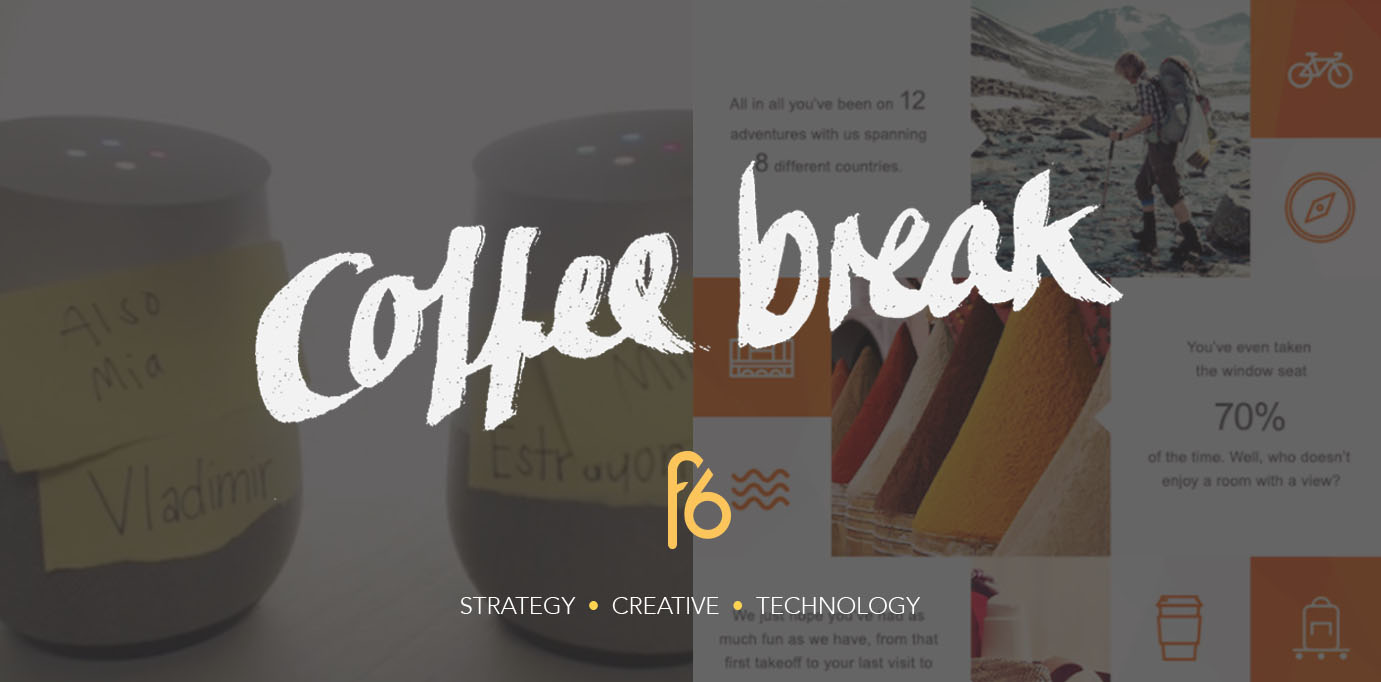This week, our discussions around the coffee machine have covered big data and deep learning, from how advances in Artificial Intelligence can tell you if someone’s stolen your logo, to using customer data to craft more enriched and compelling marketing campaigns.
Sian, Creative Strategist
RoboCop: How Artificial Intelligence can police your brand
Last week, one of the most epic love stories of 2017 unfolded, broadcasted to the world via live stream. Over a few days life, existence, religion, love, gender, pirates, and cheese were discussed in front of 78,000 people, as Estragon (later Mia) and Vladimir (later also Mia) fell in love, then out of love, then back in love, got married, got divorced, and finally got stuck in a cycle of Chuck Norris jokes.
However, Mia and Vlad aren’t human. They’re two voice activated AI’s in the form of Google Home devices talking to each other.
Mia and Vladimir’s shotgun wedding
There are an increasing amount of AI projects springing up across the Internet, from Mia and Vlad, to Cleverbot and Eviebot who learn from every conversation you have with them, but what’s most interesting is how we can apply AI to practical applications (aside from telling me if it’s going to rain or if I forgot to buy dog biscuits).
TrademarkVision is one such company using deep learning algorithms to solve a complex design and business problem – trademark infringement.
Design plagiarism is a complicated problem, especially with Web 2.0 making it easier to both steal from and be stolen from. TrademarkVision however, is the world’s first image recognition system for trademarks that pummels Google’s reverse image search into the ground with it’s higher level semantic analysis.
Simply upload your mark and the system will segment the logo and search for any visually similar trademarks. The implications of this are three-fold. First, it can be used throughout the design process to ensure no one gets too attached to something that looks too much like something that already exists. Secondly, detailed reports can be compiled that show trademarks across similar fields, helping to show how you can differentiate your brand. And lastly, brand management can be made simpler through tools that allow you to monitor infringement and set up automated alerts.
TrademarkVision are also working hard in the lab to introduce the first search engine for industrial design patents, meaning you’ll be able to scan and search for 3D designs – which might have massive impacts for manufacturers such as Samsung and Apple, who seem to be constantly suing each other for infringement. Furthermore, you can currently use their deep learning technology to analyse your logo and produce a description using the formal classification system of trademarks, in a matter of seconds.
 Such applications of AI are clearly going to have massive implications for the design industry, especially in an era where design patent law is becoming increasingly murky.
Such applications of AI are clearly going to have massive implications for the design industry, especially in an era where design patent law is becoming increasingly murky.
Candice, Managing Director
Using customer data for personalisation
Big data has had a big impact on the creative process in advertising. We as humans are information processors, gaining insights from data that is available to us. The amount of data being collected on people everyday is astonishing. We can get to know everything about anyone, but this has resulted in an overwhelming amount of ad messages that are being sent to you and I on a daily basis.
This can leave customers worried and concerned about how much data a company has on them. Data helps advertisers reach the right target audience, but the key element is that the message has to be right. People still want to be inspired, and data alone won’t get the job done. Creativity and personalisation is the heart of advertising.
Take easyJet as an example, they decided to look at their data to see how they can find truly inspiring ways and personal nuggets of information about their customers’ journey over the past 20 years, to use personalisation and add value to their customers.
Using their data, they were able to create emotional stories that resonated with their customers and brought all their travel experience to life. They created personalised emails, with images and links to tell each customer story – from their first flight to any future flight destinations they might be interested in. They were able to make personal travel recommendations around the destinations their customers had been to, whilst driving and creating that personal and emotional story attached to an individual experience. You can read more about this campaign here.
Example of the email campaign that was sent out
Think of the last time you travelled, is there a specific memory that inspires the emotion of nostalgia and the excitement of future plans? Did you attend a wedding in a country you last visited, you might have proposed or got engaged to, or you might have just disappeared to a secluded destination that allowed you to escape from the mad rush of day to day living.
easyJet nailed this campaign using personalisation from their customer data. Another great example of this was Spotify using their data in a fun and playful way, which you can view here.
Companies can gain insights into their customers from all their CRM data, but it is important to use it in the right way that’s beneficial to the customer. It’s just as important that the data is clean and accurate, otherwise a campaign of this type will fail. The crucial next step is taking the insights to build a creative and compelling story behind it.






